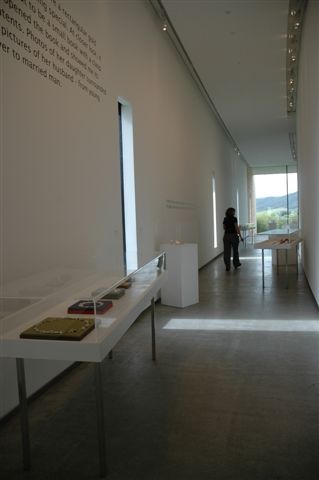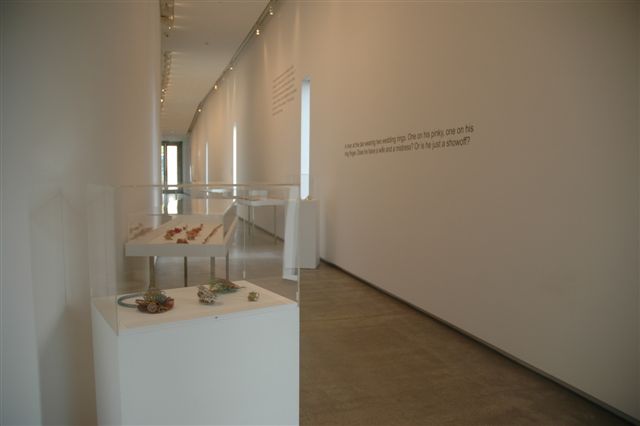TarraWarra Museum of Art is situated a short drive from Melbourne. Located in a landscape of rolling hills that juxtapose manicured vineyards with paddocks of dry grass and stands of aromatic gum trees, this impressive museum is home to the considerable collection of modern art donated, along with the building, to the people of Australia by Eva and Marc Besen.

This exhibition was originally shown in the Munich Residenz, the former Royal Palace of Bavarian monarchs. The beautiful, small catalog includes images from this European incarnation. There are glimpses of both the historical architecture and in the collections held within the palace, the skilled craftsmanship that that underpins the work of all three jeweler/artists. In one image of the show in Munich, the works are displayed on a circular table built surrounding a polished stone column and lit by gleaming little chandeliers reminiscent of that in Van Eyk’s Arnolfini Marriage and with a wall of round-arched niches as background. The image suggests that in Munich, the works had ample scope to be able to freely converse with the viewer, the sense of history and each other.
In Australia, the Vista Walk, where this exhibition is presented, is a long, narrow gallery, the end wall entirely glass and thus providing the vista that inevitably draws the viewer along the corridor to enjoy the landscape. The minimalist austerity is relieved by this and other smaller windows that look out across the valley and add their landscapes to the paintings hung in the inner galleries. The simple glass cases in which the jewelry is shown are placed at odd angles along the length of the gallery, encouraging a meandering path around the work. The work is not necessarily the same for each exhibition and provides a window into the position of each jeweler’s practice at the time of selection.

The walls of the gallery are the site for a number of texts, gathered by Rothmann and hinting at a recognition that something extra is required to create the conversations that the architecture and modernist paintings seem unable to open. The texts, some poignant and others amusing, all serve to remind visitors that in the end, the most fulfilling location for jewelry is in its relationship to the wearer. Somehow even the texts, in this location, are not enough to allow for the connections to be made. They float, each with a select cargo by one of the jewelers along the stretch of corridor, disconnected, in a further exile.
Robert Baines is renowned for his meticulous research into ancient goldsmithing techniques. In the intricate filigree of these large constructions the cognoscenti will read this relationship. However, those less familiar with the historical context have access to other more contemporary connections. Civil engineering is perhaps obvious, but there are also hints of the elaborate corsages that evoke memories of weddings and formal occasions. The placement of the work within the cases also seems designed to reinforce the formality, but Baines frequently subverts the precious gold with red paint or the inclusion of some small found object. In this exhibition his palette is widened to include other brights and pastels. The colors are frequently layered, suggesting both a temporal element and a reference to the spray-can world of graffiti. Of the pieces that remain unadorned gold, many speak of the glamour and inherent beauty of the metal but seem to lack the verve of the colored work. Others connect more directly to archaeology, ancient or modern – it is difficult to tell. Though Baines lives and works in Melbourne, his work is rarely shown so far from the source of its inspiration.

Gerd Rothmann’s jewelry is different in not directly quoting aspects of traditional jewelry. His reference comes in the elegant crafting of the pieces that derive from the thorough and meticulous training of gold- and silversmithing. Rothmann’s simple geometric shapes are saved from austerity by the humanity and humor of fingerprints. Other pieces precisely reproduce both the shape and skin textures of parts of hands or body. Though most of Rothmann’s jewelry has a palette restricted to the color of the metals he uses (gold and silver), on several pieces the prints are colored as though the work has been handled by a group involved in finger-painting. The use of color on the metal takes the undermining of minimalism even further. However, its use in the lining of several presentation boxes does little to soften the immaculate precision of both boxes and jewelry.
This exhibition may not satisfy those who want to find a meaningful subtext but is a wonderful opportunity (one that is desperately rare here, so far from Europe) to see a substantial collection of work by three exceptional jewelers. Different, each having developed their own way of expressing various aspects of traditional jewelry techniques, shapes and training, but united in the skill and relevance they bring to contemporary jewelry.




